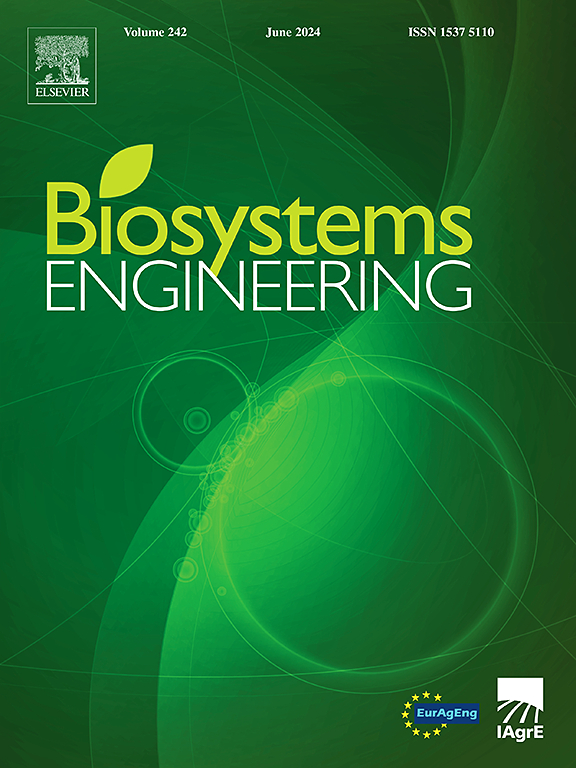Research and experimentation on an automatic teat cupattachment system for dairy cows based on visual perception
IF 4.4
1区 农林科学
Q1 AGRICULTURAL ENGINEERING
引用次数: 0
Abstract
The milking process is the most labour-intensive activity in dairy farming. Teat cup attachment is the primary challenge in realizing automatic milking. The existing AMS (automatic milking systems) primarily utilize laser/vision technology for their sensing systems, leading to slow teat sensing process and struggles with attaching teat cups to angled teats. Moreover, current depth sensing technologies fail to achieve real-time, high-accuracy 6D pose estimation (3D position and orientation) for deformable biological targets like cow teats. To address these issues, we first expand the cow udder image dataset and propose an arbitrary-oriented teat detection and target endpoint positioning method based on YOLOv8-obb. The AP (average precision) of the method is 97.82%, the average orientation error is 1.83°, the average positioning error of target endpoint is 2.04 pixels, and the detection time is 11 ms per image. Secondly, based on the morphological characteristics of the teats, combined with the teats rotated bounding boxes and binocular vision, we develop an efficient method for spatial positions and orientations calculation of teats’ target endpoints, with an average time consumption of 24.62 ms. Finally, a lightweight automatic teat cup attachment system is built to perform experiments. Among the 25 groups experiments, the average spatial positioning errors of the X, Y, and Z axes are 2.54 mm, 2.08 mm, and 3.90 mm, respectively, while the average spatial orientation errors are 1.16°, 1.28°, and 1.73°, respectively. The average time consumption for the entire process is 116.71 ms. The results prove the feasibility and accuracy of the proposed methods.
基于视觉感知的奶牛自动贴杯系统的研究与实验
挤奶过程是奶牛场劳动密集程度最高的活动。乳头杯罩是实现全自动挤奶的主要挑战。现有的全自动挤奶系统(AMS)的传感系统主要采用激光/视觉技术,导致乳头传感过程缓慢,并且难以将奶杯固定到倾斜的乳头上。此外,目前的深度传感技术无法对奶牛乳头等可变形生物目标进行实时、高精度的 6D 姿态估计(三维位置和方向)。为了解决这些问题,我们首先扩展了奶牛乳房图像数据集,并提出了一种基于 YOLOv8-obb 的任意导向乳头检测和目标端点定位方法。该方法的 AP(平均精度)为 97.82%,平均方向误差为 1.83°,目标端点的平均定位误差为 2.04 像素,每幅图像的检测时间为 11 ms。其次,根据乳头的形态特征,结合乳头旋转边界框和双目视觉,我们开发了一种高效的乳头目标端点空间位置和方向计算方法,平均耗时为 24.62 毫秒。最后,我们建立了一个轻便的自动乳头杯安装系统来进行实验。在 25 组实验中,X、Y 和 Z 轴的平均空间定位误差分别为 2.54 毫米、2.08 毫米和 3.90 毫米,平均空间方位误差分别为 1.16°、1.28° 和 1.73°。整个过程的平均耗时为 116.71 毫秒。结果证明了所提方法的可行性和准确性。
本文章由计算机程序翻译,如有差异,请以英文原文为准。
求助全文
约1分钟内获得全文
求助全文
来源期刊

Biosystems Engineering
农林科学-农业工程
CiteScore
10.60
自引率
7.80%
发文量
239
审稿时长
53 days
期刊介绍:
Biosystems Engineering publishes research in engineering and the physical sciences that represent advances in understanding or modelling of the performance of biological systems for sustainable developments in land use and the environment, agriculture and amenity, bioproduction processes and the food chain. The subject matter of the journal reflects the wide range and interdisciplinary nature of research in engineering for biological systems.
 求助内容:
求助内容: 应助结果提醒方式:
应助结果提醒方式:


